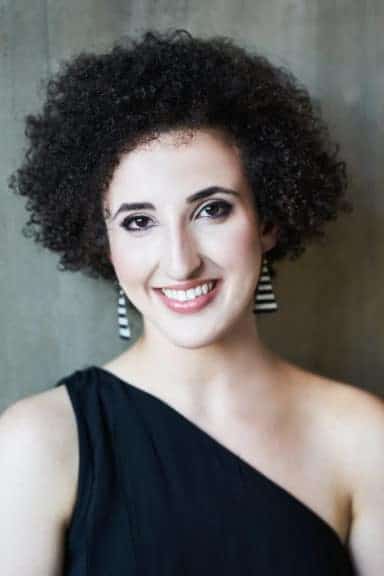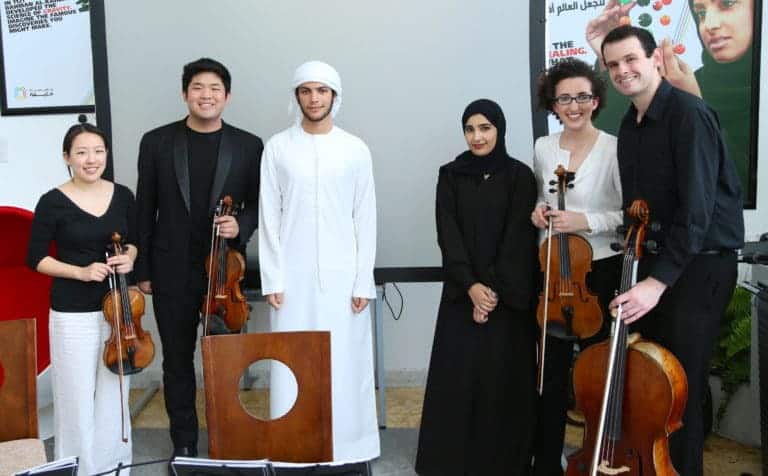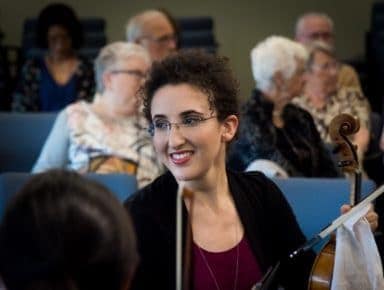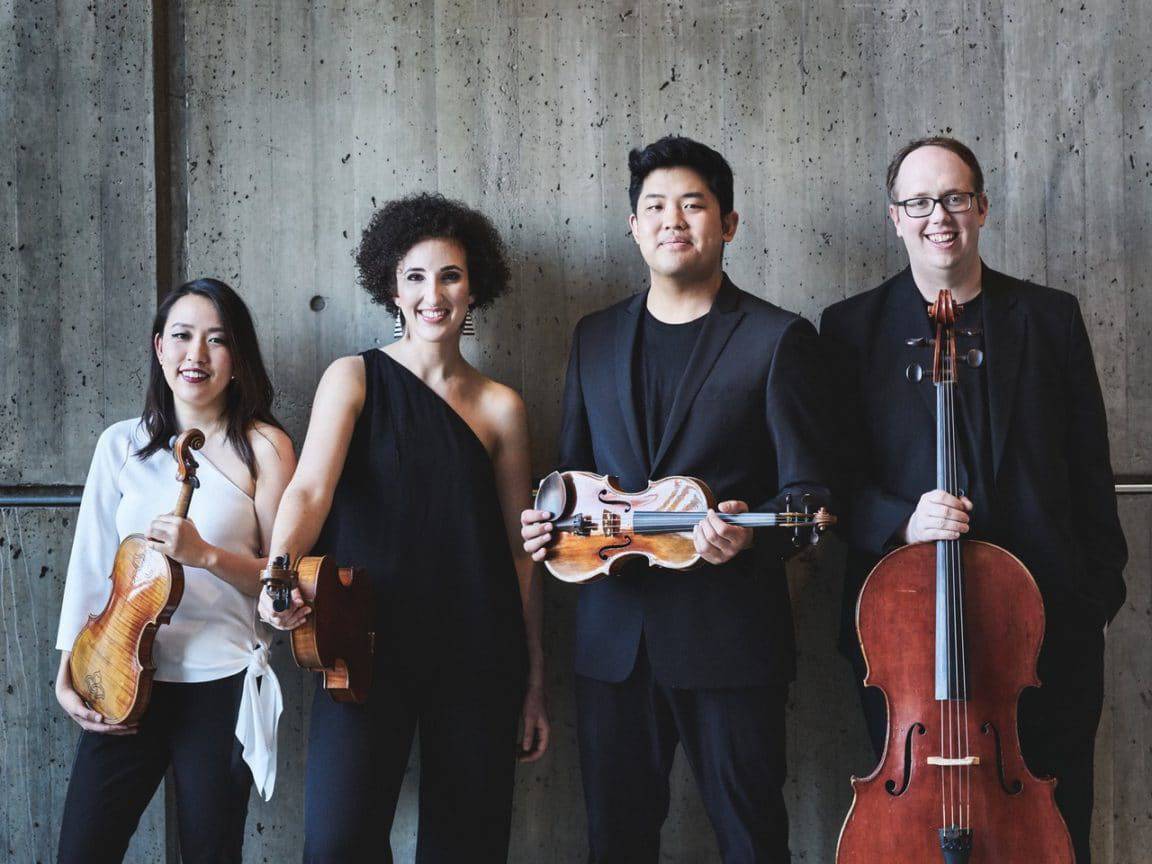It’s a good thing the Verona Quartet members are young and energetic because they’ve gotten quite a workout in Portland this month. For about two weeks between July 16 and 29, they gave concerts and educational programs as part of Chamber Music Northwest’s 2018 Summer Festival. They played Haydn at Portland State University’s Lincoln Hall on Tuesday, Shostakovich’s Quartet #3 at northeast Portland’s Alberta Rose Theater on Wednesday, Julia Adolphe’s Star-Crossed Signals at PSU’s Recital Hall on Friday, and on Saturday and Sunday at Reed College’s Kaul Auditorium they took part in the all-Dvorak program that closed the Festival. Most of the other days they participated in various community outreach activities.
Modern and Global

On a perfect Portland summer evening last week, I chatted with Abigail Rojansky, the Quartet’s violist at a courtyard picnic table at Reed, their current lodging. The Verona Quartet’s frenetic Oregon schedule is not unusual. They are a full-time ensemble — chamber music is what they do, and they do a lot of it away from home. They have given concerts and residencies in the U.S., Canada, Europe, Asia, Australia, and the Middle East. This is their eighth week on the road this summer. When I ask if any of them are married, she smiles and says no. “And the next question,” she offers, “is if any of the members of the quartet are ‘together,’ and the answer again is no.”
The Verona’s multinational touring schedule mirrors the group’s diverse backgrounds: two men, two women, four nationalities. Rojansky grew up in the San Francisco Bay area, first violinist Jonathan Ong is from Singapore, second violinist Dorothy Ro is from Nova Scotia, and cellist Jonathan Dormand hails from Yorkshire, England. To make things easier they call Dormand “J.D.”
Like every string quartet whose players I’ve ever interviewed, the Verona is particularly attracted to contemporary music. Among the new works, it has commissioned is one by Michael Gilbertson, which was recently chosen as a finalist for the Pulitzer Prize. Another, Julia Adolphe’s Star-Crossed Signals, was inspired by the signals used to communicate between ships at sea. The Verona recently performed it for the New at Noon concert in Lincoln Recital Hall at Portland State University. Rojansky is adamant that “classical” music should not be considered old-fashioned and stagnant, but that it is constantly changing, as is our understanding of it.
They chose the name, Verona, in homage to Shakespeare’s love of that great city and also in honor of their own international flavor. Although English is the language they all speak, “Music is a language of its own,” she observed. “My mother taught me to read music from before I can remember, so it’s actually my first language!”
One of their most memorable experiences was a week-long residency in Abu Dhabi in the United Arab Emirates. In addition to giving several concerts, they participated in a collaborative program involving local poets, who responded to the Quartet’s performances of Schubert’s “Death and the Maiden” Quartet and Webern’s Slow Movement (Langsamer Satz). One of the poets came up to the quartet afterward to tell them that this was one of the most important moments of her life and that she would never forget it. “We were very moved,” said Rojansky. “We won’t forget it, either.”

Mentors and Mentees
The four were students together at the Indiana University Jacobs School of Music. Rojansky and Ong are the original founding members, the other two joining a year or so later. Their principal mentors at I.U. were David Katz of the Cleveland Quartet and the members of the Pacifica Quartet, whose members gave them significant encouragement about their prospects for the future, not only because of their technical prowess but because of their humanity.
“They said that we had the right work ethic and also that we had the right attitude as people, and that was going to be extremely helpful for us in forging a career,” Rojansky remembers. “It made a huge difference. I don’t think, honestly, we would be a quartet today if it weren’t for the encouragement we received from the Pacifica.”
They then served two seasons as the Graduate Resident String Quartet at the Juilliard School of Music, where they were, in turn, mentored by the Juilliard Quartet. They are currently the quartet-in-residence at the New England Conservatory of Music’s Professional String Quartet Training Program. The members are grateful to the groups that mentored them and committed to teaching and mentoring younger musicians. They frequently play in schools and they love playing for children. “Kids are very honest with their responses,” Rojansky says. “If they like it, they tell you, and if they don’t, they tell you.”
Music in Motion
As part of their outreach program, the Verona recently visited a children’s hospital in Portland where they played for the children’s wheelchair dance class. They all danced, the musicians (except for the cellist) as well as the kids and their assistants. “It’s something we do in rehearsals a lot,” Rojansky said. “We get up and move to get the feel of the music in our bodies.”

They often incorporate movement into their outreach programs. They tell their students not only about the technical aspects of playing string quartets but also how to call upon their dramatic abilities by conveying the story of the music visually and through movement.
Rojansky talked about the importance of mimicking the body language of the player sitting across from her to enable her to understand what that person was trying to convey. “That’s how our conversation proceeds, our musical conversation. It wouldn’t be particularly interesting if we were just speaking musically in a vacuum without making the effort to understand what’s being bounced back at us. It’s about developing that language that’s both physical and aural. We don’t use our mouths — we use our bodies and our instruments to speak instead.”
Communication is essential to creating great chamber music. Rojansky recalled the Verona’s experience at a recent festival in Vancouver where the quartet’s members were teaching high-level amateurs, one of whom was an emergency room physician. The doctor declared that the best way to learn empathy was to play in a string quartet, that chamber musicians are exceptionally attuned to one another’s emotions and that she would use what she had learned there in her medical practice.
An essential part of chamber musicians’ communication involves the process of giving and receiving criticism. When I asked if it didn’t sting sometimes, she replied, “Of course.” But she and her partners do it day in and day out for hours at a time. “You really have to know how to give criticism constructively,” she said, “when to give it and when not to give it, then also how to receive it graciously and apply it in a way that’s not breaking your ego down, but actually helping you to be a better musician. At the same time, you have to be vulnerable enough to absorb what’s being shared with you. You have enough appreciation and respect for them as artists that you actually want to know what they think.”
She went on to tell me about a process they learned from the Cavani Quartet, another of their mentors. It’s called “Live, Breathe, and Die,” which the Verona have abbreviated Lbad. “It means,” she explained, “live, breathe, and die for everything that someone is doing, and that’s how you know what they’re trying to say. It’s that notion of mimicry — like really, really being one with who they are for a minute. It’s that kind of generosity where you just give yourself up to what the other person is thinking, feeling, and doing.”
The group’s close musical connections pay off in performance. In a review of a recent concert in La Jolla, the San Diego Story reported that a Haydn quartet “was delivered with delicate perfection by the Verona players, who play and breathe as one.” I asked Rojansky how “playing and breathing as one” affects their individuality as musicians. She replied that they always strive for unity, “but what we don’t want to do is paint over the lines of our individuality. We want to celebrate them and use them to best effect, so we think it’s important to do both — to be unified and to be individuals.” When I pointed out that it’s an awfully delicate balance, she replied, “That’s where those six hours of rehearsal come in.”




2 thoughts on “Verona Quartet: musical conversations”
I can’t believe I get to hear all this fantastic music besides learn about being in a string quartet!
Bravo Alice!
Glad you enjoyed it. Thanks for the comment!